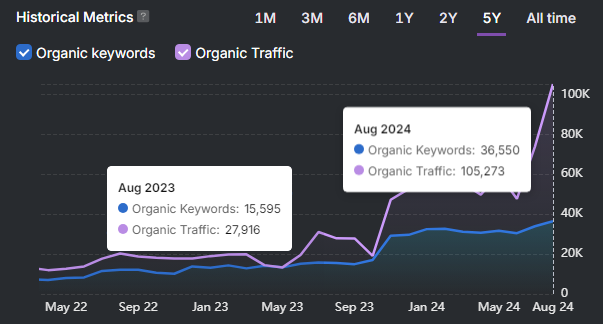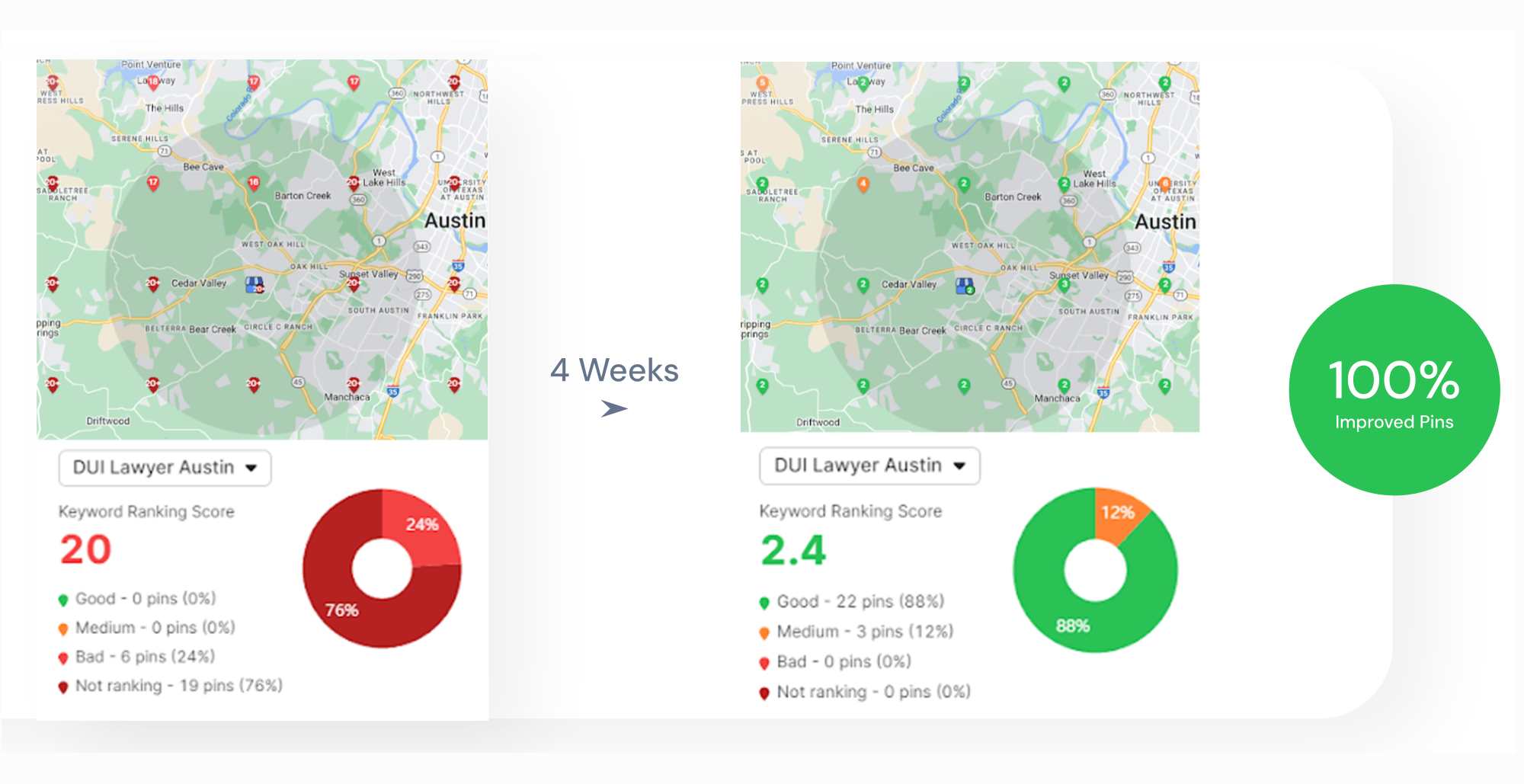SEO maintenance refers to the ongoing process of monitoring, optimizing, and updating a website to keep it aligned with current search engine algorithms and user expectations. SEO maintenance includes a wide range of tasks such as fixing technical errors, updating outdated content, improving page speed, optimizing internal links, managing local SEO, and tracking keyword performance. The importance of SEO maintenance lies in its ability to ensure a website remains competitive in search rankings, adapts to algorithm updates, and meets evolving user behavior.
Businesses can perform effective SEO maintenance by consistently tracking and analyzing website performance, conducting technical audits, refreshing existing content, optimizing internal links, identifying content gaps, reviewing site architecture, evaluating topical authority, recrawling using NLP tools, analyzing backlink profiles, and managing local SEO. Together, these efforts strengthen a website’s search performance and help drive sustainable organic growth.
What is SEO Maintenance?
SEO maintenance is the ongoing process of monitoring, updating, and optimizing a website to maintain and improve its visibility in search engine results pages (SERPs). SEO maintenance involves regularly reviewing technical performance, content relevance, keyword rankings, and backlink health to make sure the site complies with the latest search engine algorithms and continues to attract organic traffic.
The common SEO maintenance tasks include fixing broken links, updating outdated content, optimizing page speed, enhancing mobile responsiveness, refreshing meta tags, tracking keyword performance, and monitoring competitors’ activities. Regular SEO maintenance helps businesses safeguard their online presence, improve user experience, and sustain long-term digital growth.
Effective SEO maintenance requires consistent effort rather than one-time fixes, as search engines continuously update their algorithms and competitors actively work to upgrade their own rankings. The lack of continuous SEO maintenance efforts can cause even the most well-optimized websites to experience a decline in search visibility due to technical issues, outdated content, or failure to adapt to evolving search engine requirements without regular maintenance.
What is the Importance of SEO Maintenance?
The importance of SEO maintenance lies in how search engines operate in the digital world. Search engines like Google continuously update their algorithms, which can significantly impact how websites rank and appear in search results. Without regular SEO maintenance, a website can lose its visibility, resulting in decreased traffic and lost business opportunities. Regular SEO maintenance guarantees that a website remains aligned with current SEO best practices, which helps maintain its performance and competitive edge in the digital space.
Technical aspects of websites naturally degrade over time without proper maintenance intervention. For example, links break due to various factors, page loading speeds may slow down, and mobile compatibility issues can emerge. These technical problems directly impact user experience, which search engines increasingly prioritize in their ranking algorithms. Ongoing SEO maintenance identifies and resolves these issues before they negatively affect search performance.
Scheduled SEO and content maintenance keep website content relevant and accurate, as user intent, keywords, and industry trends often evolve over time. Consistently updating and optimizing content guides a business to continue to meet audience needs while signaling to search engines that the site is active and trustworthy. Most importantly, effective SEO maintenance plays a vital role in sustaining and improving search rankings over time, as search engines favor websites that are fast, secure, regularly updated, and user-friendly. A lack of ongoing maintenance can affect even well-ranked pages and cause them to gradually lose their positions to better-maintained competitors, making SEO maintenance essential for long-term online success.
How to Do SEO Maintenance?
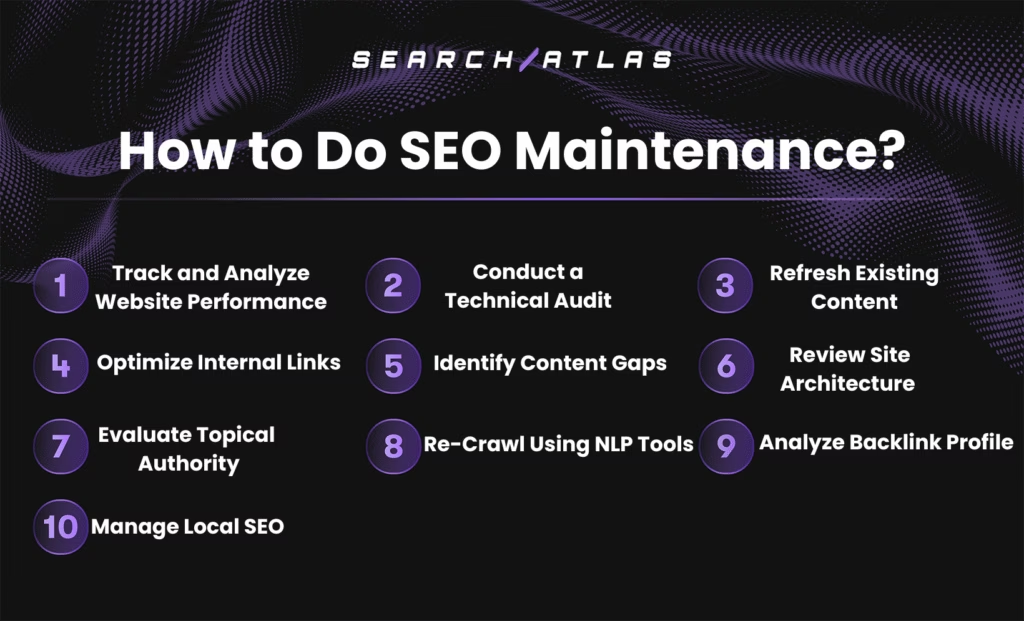
There are 10 steps to follow when doing SEO maintenance and ensure your website stays optimized for search engines and continues to perform well over time. The 10-step SEO maintenance checklist is given below.
1. Track and Analyze Website Performance
Tracking and analyzing website performance involves monitoring key metrics related to how users interact with your site and how your pages perform in search engines. Tracking and analyzing website performance includes data such as page views, bounce rate, session duration, conversion rates, and organic search traffic.
Tracking and analyzing website performance improves SEO by providing concrete data that reveals optimization opportunities and identifies problems before they damage search rankings. Performance analysis uncovers technical issues like slow loading speeds, broken links, or crawl errors that prevent search engines from properly indexing content while revealing which keywords drive traffic and which pages perform best for targeted optimization efforts. The data exposes user behavior patterns through metrics like bounce rate, time on page, and click-through rates, which search engines use as ranking signals to evaluate content quality and user satisfaction. Additionally, regular monitoring enables quick detection of ranking drops or algorithm impacts, allowing rapid responses to maintain search visibility.
The best practices for tracking and analyzing website performance are outlined below.
- Use tools like Google Analytics and Search Console to track traffic sources, user behavior, keyword performance, and technical issues.
- Monitor keyword rankings for target terms using tools like the Search Atlas Keyword Rank Tracker Tool.
- Set up custom goals and conversions to measure specific actions like form submissions, purchases, or downloads.
- Monitor bounce rates and average session duration to evaluate content relevance and user engagement.
- Track page load speed and mobile performance using tools like PageSpeed Insights or GTmetrix.
- Segment your traffic by channel, device, and location to identify patterns and target opportunities more effectively.
- Review landing page performance to see which pages attract the most organic traffic and which need optimization.
- Create regular performance reports to track progress and identify trends over time.
- Perform competitor analysis to benchmark your site’s performance against industry peers.
The Search Atlas Keyword Rank Tracker Tool automatically checks the rankings of your target keywords at your chosen frequency and provides insights into key metrics, including current position, search volume, SERP features, and ranking trends over time, to help you evaluate your keyword performance and adjust your SEO strategy accordingly. Additionally, the Search Atlas Keyword Rank Tracker Tool provides a detailed overview of the number of keywords your competitors have in the top 10 and the rate of their search visibility to help you identify content gaps and possible ranking opportunities.
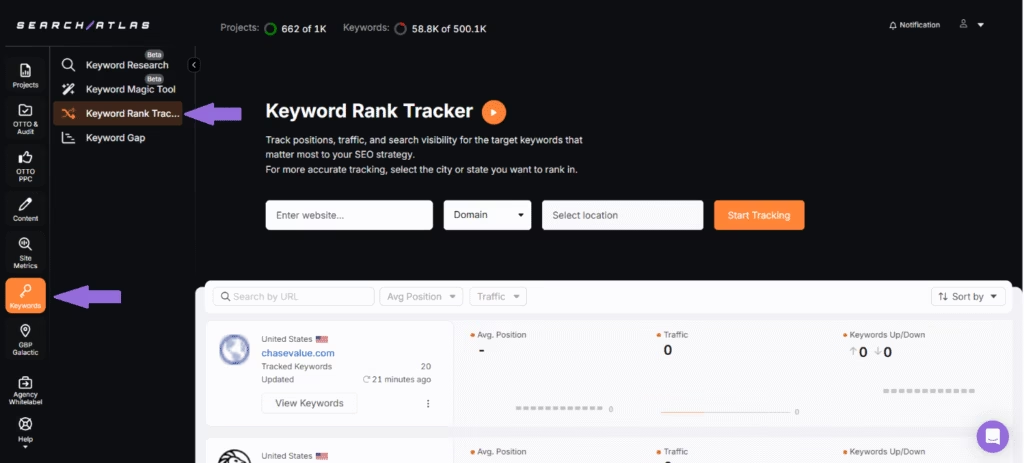
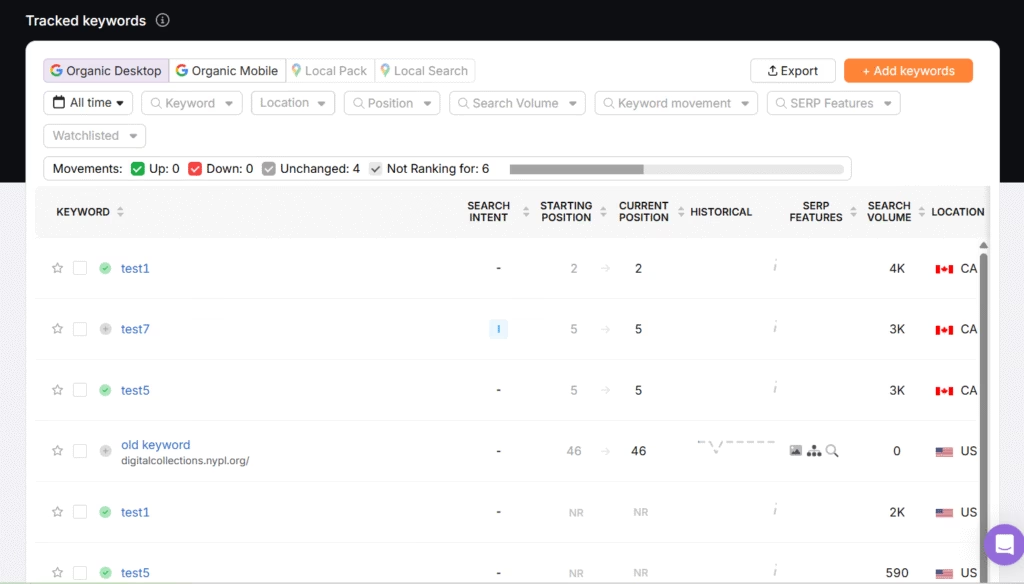
2. Conduct a Technical Audit
Conducting a technical audit refers to identifying and fixing website issues that block search engines from crawling, indexing, and ranking pages. A technical audit checks the backend elements that impact site visibility, including crawl errors, page speed, mobile usability, and site structure.
Conducting technical audits improves SEO by uncovering problems that reduce performance in search results. Search engines rely on clean code, fast-loading pages, and structured data to rank content. Technical issues weaken SEO by slowing down the site, confusing crawlers, and damaging user experience. Fixing these problems strengthens crawlability, boosts indexation, and increases ranking potential.
The tips for conducting a technical audit are mentioned below.
- Use tools like the Search Atlas Site Auditor Tool to scan the website for technical errors.
- Check for crawl issues, broken links, redirect chains, and duplicate content.
- Verify that your site has a clean and simple URL structure.
- Optimize page speed by compressing images, removing unnecessary scripts, and enabling browser caching.
- Test mobile usability to guarantee fast loading, responsive design, and tap-friendly navigation.
- Audit XML sitemap and robots.txt to confirm proper indexing instructions for search engines.
- Check HTTPS status to avoid mixed content and verify secure connections.
- Review structured data markup to support enhanced search features like rich snippets.
The Search Atlas Site Auditor Tool provides a detailed overview of your website’s technical performance by identifying issues related to crawlability, indexability, and site structure. Simply enter your domain, set the maximum number of pages to crawl, configure the crawl frequency, and click “Start Audit.” The Search Atlas Site Auditor Tool then scans your pages and highlights the most critical SEO issues using customizable Page Explorer reports.
The Search Atlas Site Auditor Tool allows you to combine crawl data with metrics from Google Search Console and Google Analytics to help you quickly identify problems on your most important landing pages. This type of targeted, data-driven analysis makes sure your website’s technical foundation is solid and supports better search visibility and long-term SEO success.
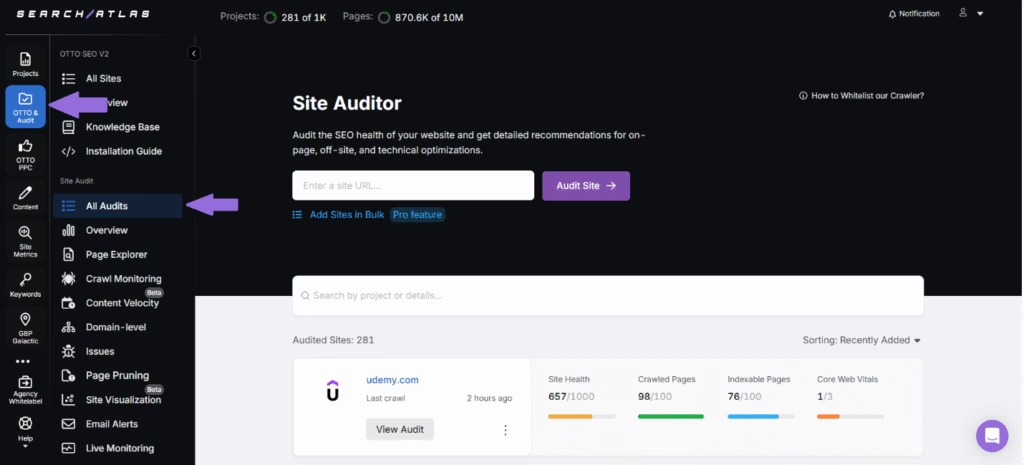
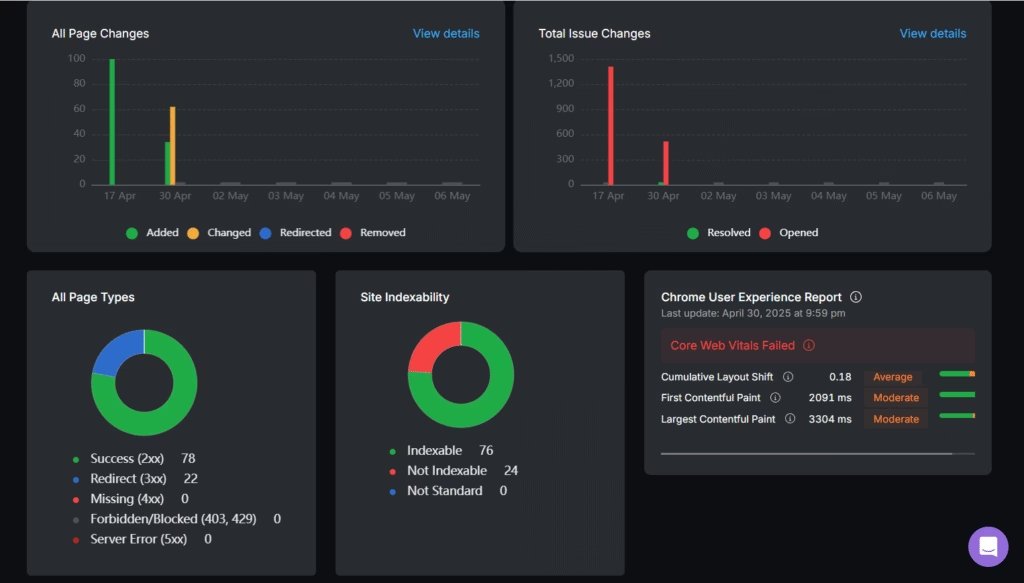
3. Refresh Existing Content
Refreshing existing content refers to the process of updating, improving, and optimizing previously published website content to maintain its relevance, accuracy, and search engine performance. Refreshing existing content involves revising outdated information, adding new insights, improving formatting, updating keywords, and increasing overall content quality to meet current user needs and search engine standards.
Refreshing existing content helps improve SEO by signaling to search engines that the website remains active and provides current, valuable information to users. Updating existing content allows for the integration of new keywords and search terms that have gained popularity, expanding the content’s ability to rank for additional relevant queries. Revamping existing website content boosts user engagement metrics like time on page and bounce rate by providing more comprehensive, accurate, and useful information that better satisfies search intent. Additionally, the process enables the addition of internal links to newer pages, improving site architecture and distributing page authority more effectively throughout the website.
To refresh existing content, start by using tools like the Search Atlas Scholar Tool and the Search Atlas On-Page Audit Tool to audit your existing content and evaluate its relevance, structure, and depth around a targeted keyword. Leverage the Search Atlas Content Genius Tool to optimize the existing content with relevant keywords, topical terms, and links. Update statistics, data, and factual information to ensure accuracy and maintain credibility with users and search engines. Add new sections or expand existing topics to provide more comprehensive coverage of the subject matter.
Additionally, add internal links to relevant new content and fix broken outbound links. Enhance meta titles and descriptions to reflect updated content and increase click-through rates from search results. Update the publish date to reflect the changes and show freshness in search results. Resubmit updated URLs in Google Search Console to encourage faster re-indexing. Add schema markup using tools like the Search Atlas Schema Markup Generator Tool to the improved content for better search result appearances and increased visibility.
The Search Atlas Scholar Tool grades your content against Google’s Page Quality Algorithm and information retrieval principles and provides clear, actionable insights to help you improve content quality and search performance. To review your content using the Search Atlas Scholar Tool, simply enter your target keyword, upload your content, URL, or draft, and click “Analyze Page.” The Search Atlas Scholar Tool will then assess your content from all angles and generate a data-driven score, highlighting specific areas for optimization.
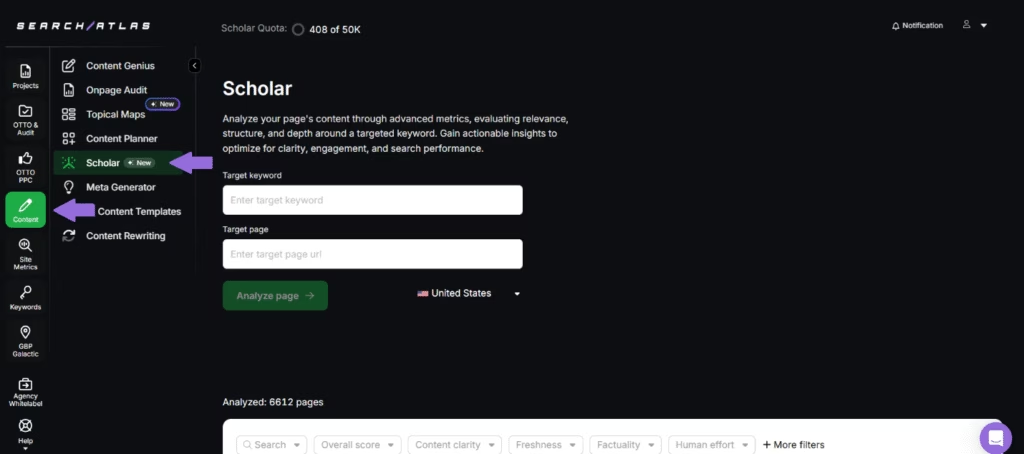
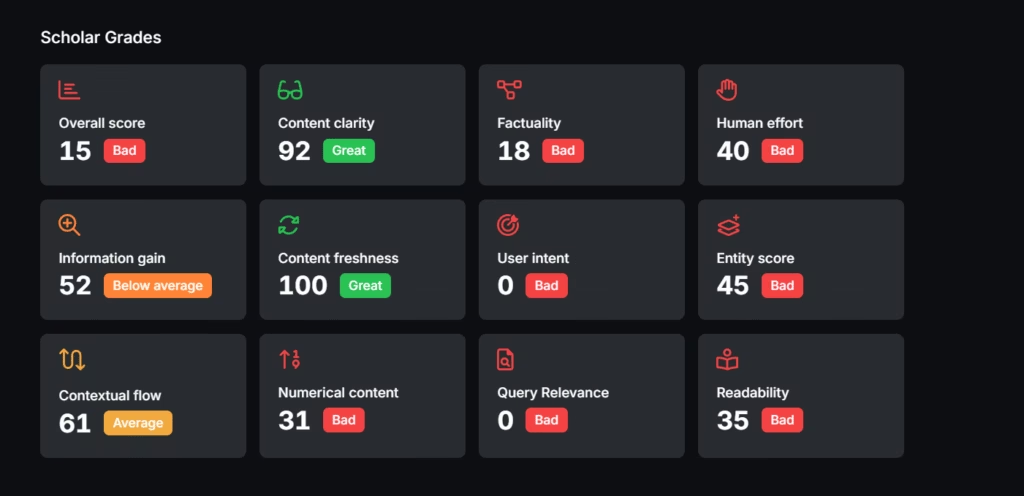
Additionally, the Search Atlas On-Page Audit Tool evaluates your content quality and SEO by analyzing key elements such as content score, word count, and readability. The Search Atlas On-Page Audit Tool allows you to compare your page against the top 10 ranking competitors for your target keyword to identify the areas where your content may fall short and need improvement. With detailed insights and guidance, the Search Atlas On-Page Audit Tool makes sure your content is relevant and engaging and aligns with what search engines prioritize to help you improve visibility, boost rankings, and better connect with your target audience.
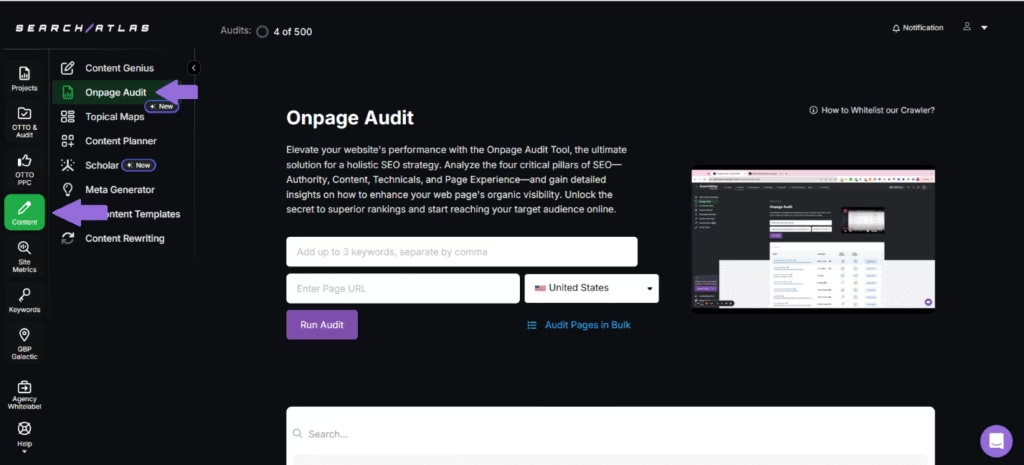
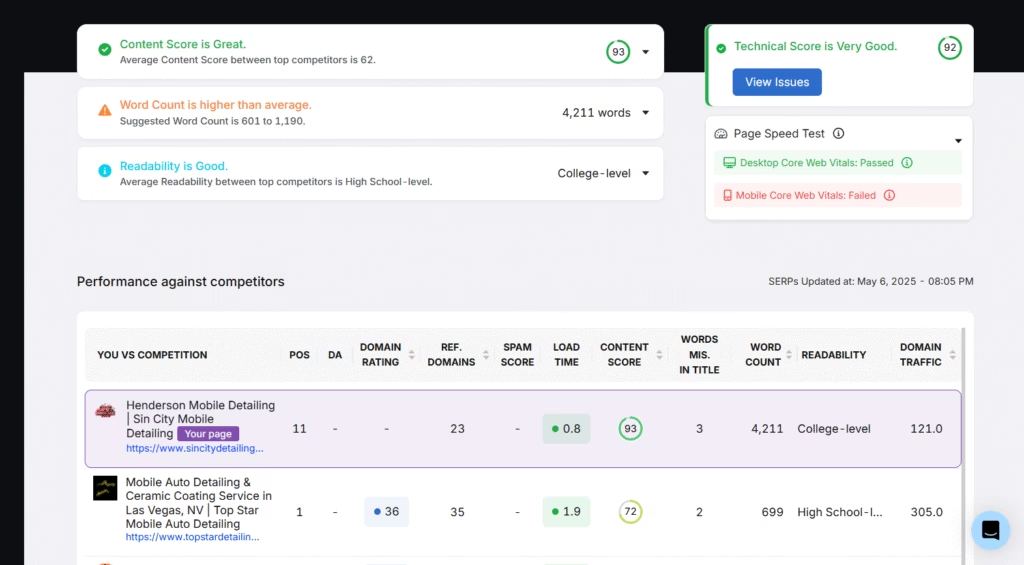
The Search Atlas Content Genius Tool is an AI-powered tool designed to simplify and improve the content creation and optimization process. The Search Atlas Content Genius Tool combines integrated keyword research, SERP analysis, and NLP-driven suggestions to help you create SEO-optimized articles effortlessly. The Search Atlas Content Genius Tool analyzes top-performing content for your target keywords and generates detailed content briefs, including suggested headings, relevant questions, topical terms, and recommended links.
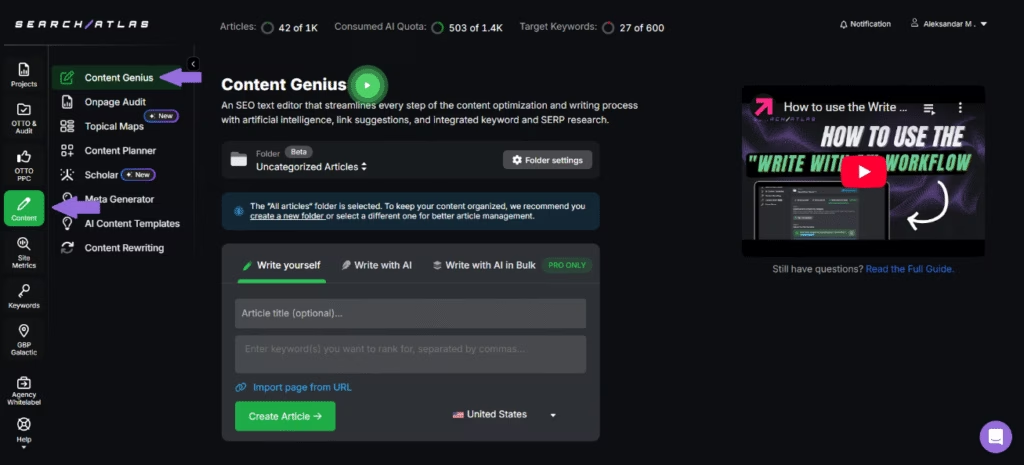
The Search Atlas Schema Markup Generator Tool helps you create accurate JSON-LD markups for your website, including all required and optional item properties. The Search Atlas Schema Markup Generator Tool is designed to streamline structured data implementation and help make sure your markup is aligned with Schema.org standards. After implementation, the Search Atlas Schema Markup Generator Tool lets you easily test your generated markup using built-in links to Google’s Structured Data Testing Tool and Rich Results Test, making it simple to validate and optimize your content for improved search visibility.
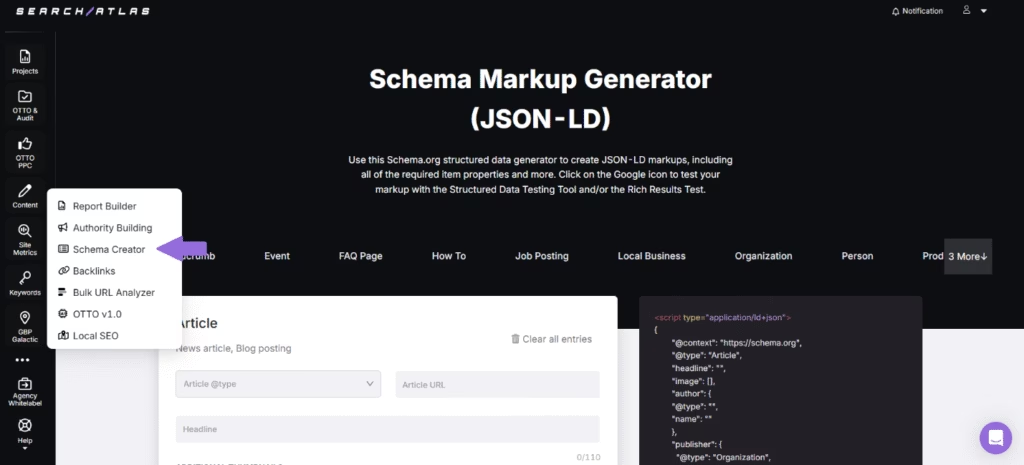
4. Optimize Internal Links
Optimizing internal links refers to the process of improving the structure, placement, and anchor text of links that connect different pages within the same website to refine navigation, user experience, and search engine crawling efficiency. Optimizing internal links involves creating logical link hierarchies, using descriptive anchor text, and verifying the proper distribution of page authority throughout the site architecture.
Optimizing internal links helps boost SEO by directing search engine crawlers to important pages and distributing page authority (link juice) effectively across the website. Strategic internal linking improves user experience by providing relevant pathways for visitors to find additional valuable content, which increases engagement metrics.
Effective internal linking helps establish page hierarchy and importance, allowing websites to signal to search engines which pages deserve higher priority in search results. Additionally, the process enables better keyword targeting through descriptive anchor text that provides context about linked pages, helping search engines understand content themes and increase rankings for target keywords.
To optimize internal links, use descriptive anchor text that includes target keywords and clearly indicates the linked page topic. Vary the anchor text for links pointing to the same page to avoid over-optimization and maintain natural linking patterns. Link to high-priority pages from related, high-traffic pages to pass authority and drive engagement. Implement breadcrumb navigation to provide a clear site hierarchy and increase user experience across all pages.
Additionally, use a mix of navigational, contextual, and footer links to strengthen user flow and content visibility. Limit excessive linking on one page to maintain clarity and avoid dilution of link value. Add internal links during content creation and revisit older content to insert new relevant links. Run regular internal link audits using tools like the Search Atlas On-Page Audit Tool to identify and fix broken, redirected, or orphaned links.
The Search Atlas On-Page Audit Tool serves as an effective way to check and optimize internal linking across your website. The Search Atlas On-Page Audit Tool helps identify broken links that disrupt user experience, orphaned pages that are not linked from any other part of your site, and redirect chains that can waste crawl budget and slow down site performance.
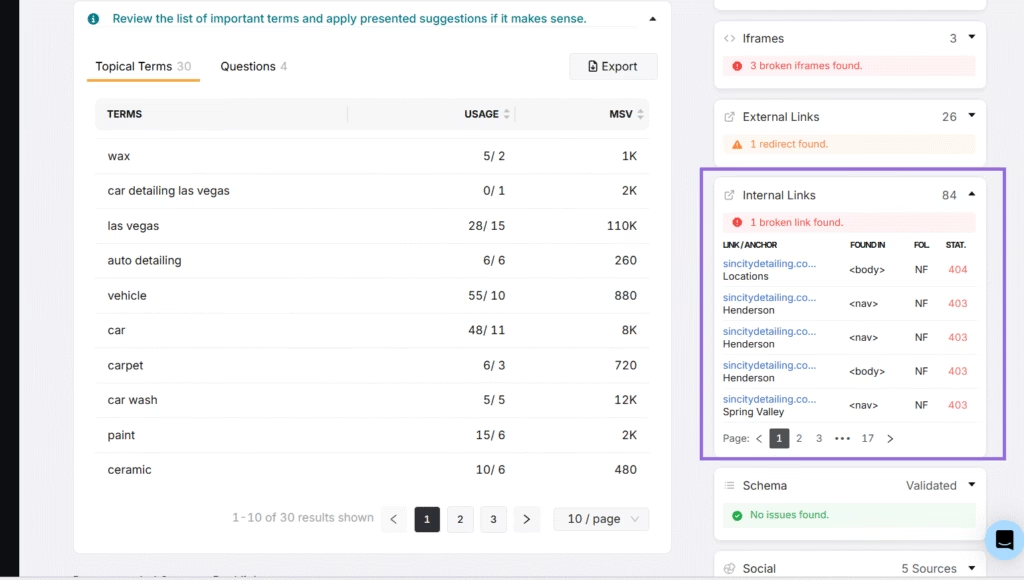
Additionally, the Search Atlas On-Page Audit Tool provides internal linking recommendations to strengthen your site’s structure by improving navigation, increasing crawlability, and guaranteeing better distribution of link equity.
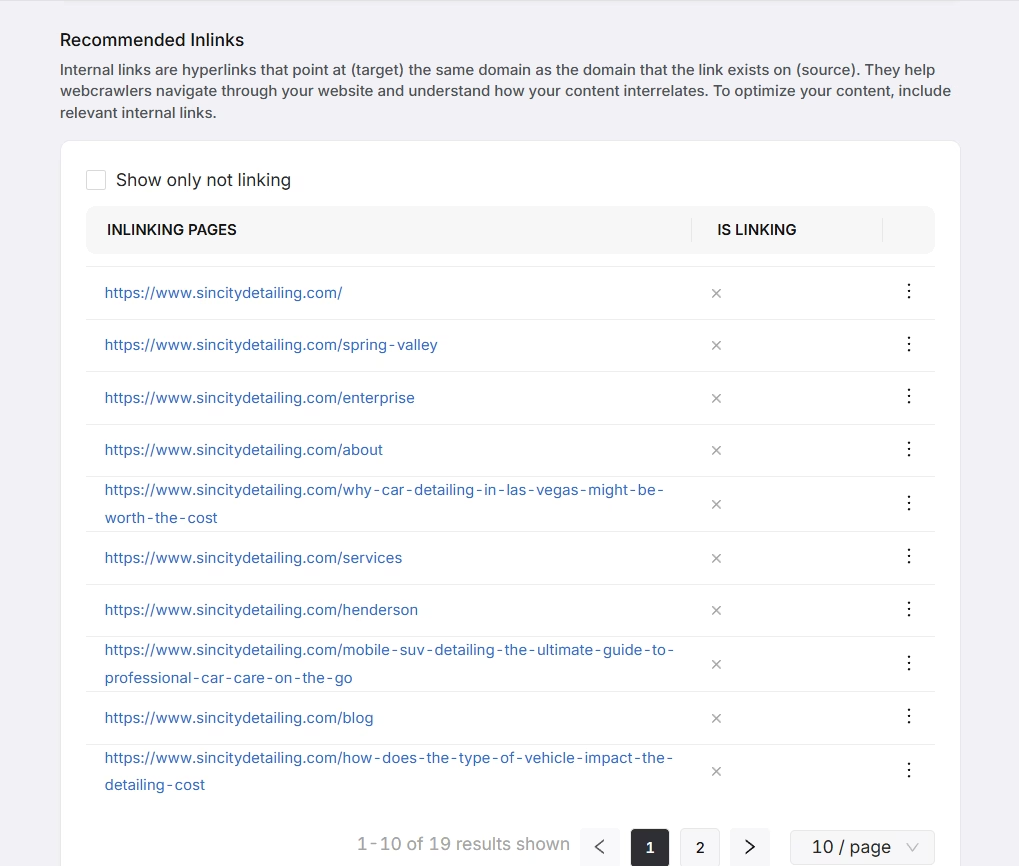
5. Identify Content Gaps
Identifying content gaps refers to the process of discovering missing topics, keywords, or content pieces that target audiences search for but the website does not adequately cover. Identifying content gaps involves analyzing competitor content, keyword research data, and user search behavior to find opportunities where new content can capture organic traffic and improve search visibility.
Identifying content gaps improves SEO by revealing untapped keyword opportunities that competitors may be ranking for while the website remains absent from those search results. Analyzing content gaps helps expand topical authority by ensuring comprehensive coverage of subject areas, which search engines reward with better rankings across related keywords. The process reveals user intent patterns and search behaviors that inform content strategy, allowing websites to create content that directly addresses audience needs and questions. Additionally, effective content gap analysis exposes weaknesses in the current content strategy where competitors gain advantages, providing clear direction for content creation priorities that can reclaim lost market share.
To identify content gaps, use tools like the Search Atlas Keyword Gap Tool to compare your content with top competitors. Analyze user queries, keyword trends, and “People Also Ask” results to find missing topics. Review on-site analytics to identify high-exit pages and low-engagement content that may lack depth. Explore community forums, social media, and customer feedback to uncover recurring questions and interests.
Additionally, use Google Trends to identify seasonal or emerging topics that present content opportunities. Examine Google autocomplete suggestions and related searches for additional keyword and topic ideas. Map existing content to the buyer journey and identify stages (awareness, consideration, decision) with low content volume. Look for long-tail keyword opportunities to target specific search intents. Prioritize high-potential gaps based on search volume, competition level, and business relevance.
The Search Atlas Keyword Gap Tool compares the keyword performance of your website with up to six competitors to reveal high-value terms your competitors rank for but you don’t, and highlight gaps in your content strategy. The Search Atlas Keyword Gap Tool enables you to expand your keyword coverage, target new search queries, and strengthen your competitive position in search results.
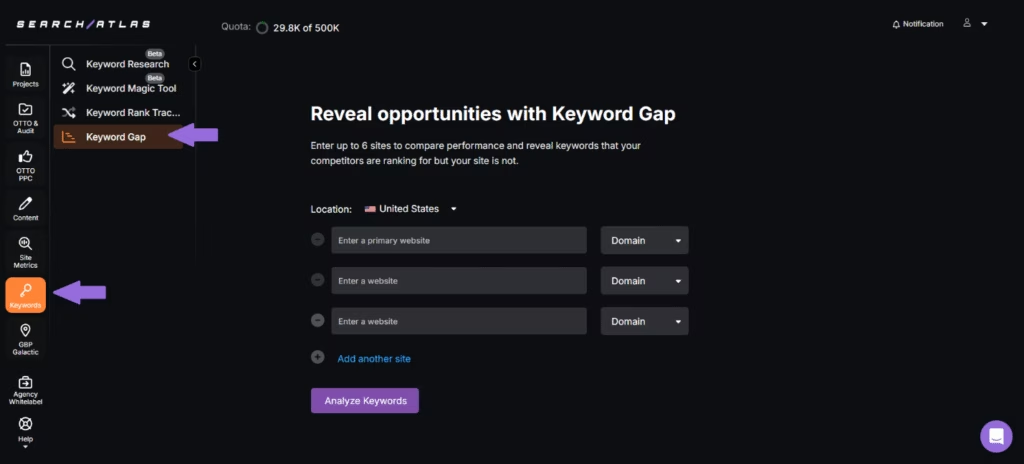
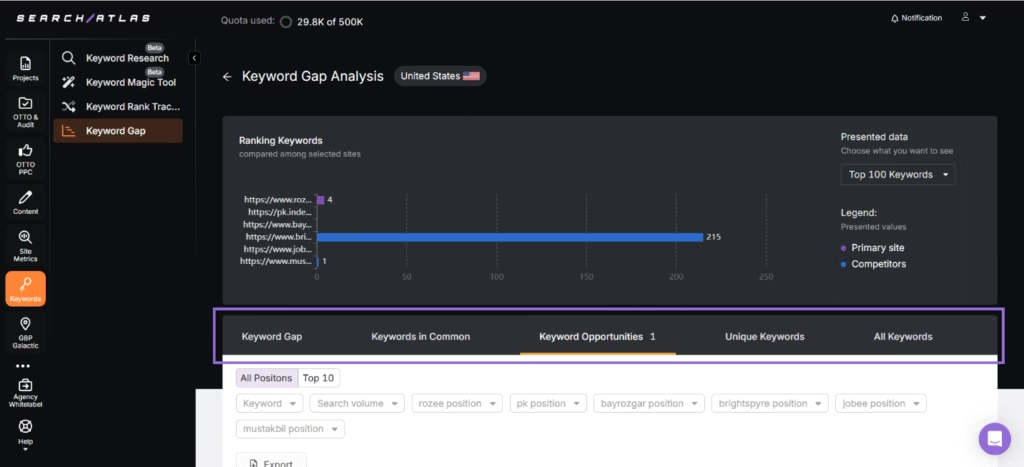
6. Review Site Architecture
Reviewing site architecture refers to evaluating how a website organizes, structures, and connects its pages, content, and navigation elements to guarantee logical hierarchy and optimal user experience. Reviewing site architecture involves examining URL structure, navigation menus, internal linking patterns, and content categorization to identify areas where organizations can improve for better usability and search engine crawling.
Reviewing site architecture helps improve SEO by creating clear pathways for search engine crawlers to discover and index all important pages efficiently. Well-structured architecture distributes page authority effectively throughout the website, making sure that valuable link equity flows to important pages rather than getting trapped in poorly connected sections. Additionally, logical site structure boosts user experience by making navigation intuitive and reducing bounce rates, which search engines interpret as positive engagement signals.
The tips for reviewing site architecture are listed below.
- Create a visual sitemap to understand the current page hierarchy and identify structural weaknesses or orphaned pages.
- Make sure important pages remain within 3-4 clicks from the homepage to maintain crawl accessibility and authority flow.
- Review URL structure for consistency, readability, and logical categorization that reflects content hierarchy.
- Analyze navigation menus to check if they provide clear pathways to all major content sections and important pages.
- Evaluate breadcrumb navigation implementation to provide a clear location context for users and search engines.
- Review category and tag structures on blogs or e-commerce sites to prevent content cannibalization.
- Assess mobile navigation functionality to ascertain that the architecture works effectively across all device types.
- Use crawling tools to visualize site structure and identify broken navigation pathways.
- Check for redirect chains or loops that may confuse search engines and waste crawl budget.
- Test user journey flows to ensure logical progression from landing pages to conversion or information goals.
Regular site architecture reviews prevent structural problems from accumulating over time. Most websites benefit from quarterly architecture assessments to maintain optimal organization. These reviews become particularly important during website redesigns, content migrations, or significant expansion phases.
7. Evaluate Topical Authority
Evaluating topical authority refers to assessing how well a website demonstrates expertise, comprehensiveness, and credibility within specific subject areas or industry niches. Evaluating topical authority involves analyzing content depth, coverage breadth, and external recognition signals.
Evaluating topical authority helps improve SEO by identifying strengths and weaknesses in content expertise that directly impact search rankings. Search engines prioritize websites that demonstrate comprehensive knowledge and trustworthiness in specific topics over generalist sites with shallow coverage. Reviewing topical authority reveals content gaps where competitors establish stronger authority and provides clear direction for content creation that can capture market share. Additionally, assessing topical relevance and depth helps identify opportunities to expand expertise into adjacent topics and creates pathways for broader search visibility while maintaining focus.
The tips for evaluating topical authority are given below.
- Audit content clusters to confirm full coverage of key subtopics, questions, and user intents.
- Check internal links between related articles to support semantic relationships and site structure.
- Use SEO tools like the Search Atlas Site Explorer Tool to compare keyword coverage and ranking strength against top competitors.
- Review external backlinks to topic-focused pages to measure authority signals from other websites.
- Analyze content depth, accuracy, and originality to confirm expertise within each topic.
- Identify content gaps that weaken authority and create new pages to close them.
- Evaluate engagement metrics like bounce rate, time on page, and scroll depth to gauge content value.
- Track performance improvements after publishing new supporting content to assess growth in authority.
The Search Atlas Site Explorer Tool’s Topical Dominance Tab helps you compare your website’s topical authority against competitors for specific subject areas. Simply enter your site and a competitor’s, and the Search Atlas Site Explorer Tool’s topical dominance tab analyzes and scores how well each site covers various topics, highlighting strengths and gaps. Additionally, the Search Atlas Site Explorer Tool’s topical dominance tab pinpoints content areas where your site is underperforming, allowing you to refine your strategy.
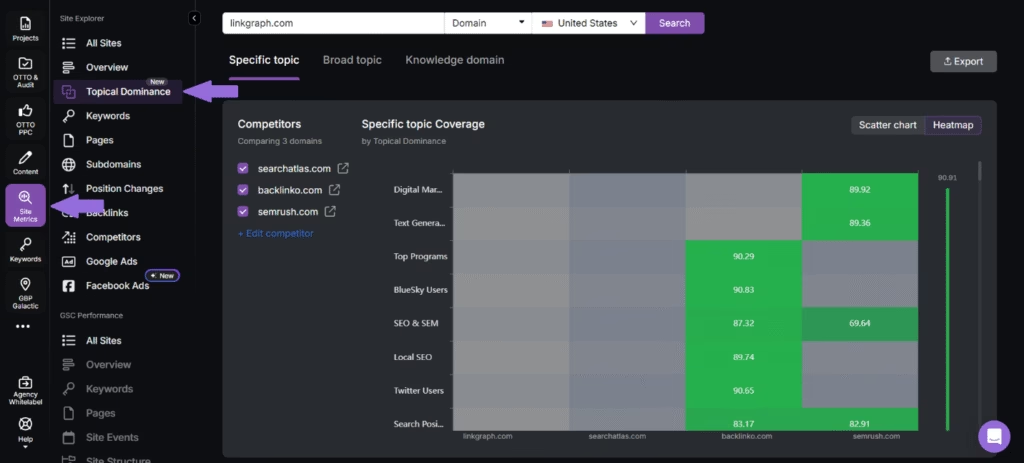
8. Re-Crawl Using NLP Tools
Recrawling using NLP tools refers to the process of re-examining website content through Natural Language Processing technology to analyze semantic meaning, content relevance, and topical relationships that traditional crawlers might miss. This advanced approach uses artificial intelligence to understand context, user intent, and content quality beyond basic keyword matching.
Recrawling using NLP tools improves SEO by providing insights into how search engines understand and categorize content semantically. Analyzing using NLP tools reveals content gaps where topics lack sufficient semantic depth or context that modern search algorithms expect. Assessing site content with NLP tools helps identify opportunities to optimize for semantic search and related keywords that traditional keyword research might overlook. Additionally, NLP crawling helps refine content structure by revealing how well pages answer user questions and satisfy search intent.
To recrawl using NLP tools, start by selecting an appropriate NLP-powered SEO tool that can analyze website content semantically. Connect the chosen tool to your website or input URLs for analysis. The tool then crawls your content and processes it through NLP algorithms to understand the semantic meaning, topic coverage, and content relationships.
Next, configure the analysis parameters by specifying target keywords, competitor websites, or topic areas you want to evaluate. The NLP system compares your content against top-ranking competitors and identifies semantic gaps or optimization opportunities. Finally, review the generated reports that highlight content recommendations, semantic keyword suggestions, and structural improvements based on natural language understanding rather than traditional keyword density metrics.
NLP-based recrawling should be performed monthly or quarterly, depending on content volume and update frequency. These tools provide deeper insights than traditional SEO analysis but require interpretation and strategic implementation.
9. Analyze Backlink Profile
A backlink profile represents the complete collection of all external links pointing to your website from other domains across the internet. A backlink profile includes every inbound link’s characteristics, including the authority and relevance of referring domains, anchor text distribution, link attributes (follow/nofollow), and the overall pattern of link acquisition over time.
Analyzing your backlink profile strengthens your SEO strategy by providing critical insights into your website’s authority, relevance, and competitive positioning. Analyzing your backlink profile helps identify harmful links that could trigger penalties, reveals which content naturally attracts valuable backlinks, uncovers gaps between your profile and competitors’, and helps maintain a natural link pattern that aligns with search engine guidelines.
Regular backlink assessment allows you to capitalize on successful link-building tactics while avoiding potentially damaging practices that could undermine your SEO efforts. A thorough backlink profile analysis informs your content strategy by highlighting which resources earn the most powerful endorsements, enables you to disavow toxic links before they harm your rankings, and provides measurable benchmarks to track your authority growth over time.
The best practices to analyze your backlink profile are outlined below.
- Use tools like the Search Atlas Backlink Research Tool to generate a comprehensive backlink report, including referring domains, anchor texts, and link types.
- Evaluate the authority and relevance of linking domains by checking their Domain Rating (DR), traffic, and topical alignment with your content.
- Inspect anchor text distribution to detect overuse of exact-match keywords, which may signal manipulation.
- Identify toxic or spammy backlinks by looking for links from link farms, irrelevant directories, or sites with a history of penalization.
- Check for sudden spikes or drops in backlinks to identify possible negative SEO attacks or technical issues.
- Monitor dofollow vs. nofollow ratios to maintain a natural-looking link profile.
- Review the linking page content to make sure it is contextually relevant and not misleading.
- Track link velocity over time to understand if backlink acquisition appears natural or suspicious.
- Look for broken or lost backlinks that previously contributed to authority and consider reclaiming them.
- Use tools like the Search Atlas Backlink Profile Comparison Tool to compare your backlink profile against competitors and discover gaps and opportunities in your SEO strategy.
The Search Atlas Backlink Research Tool helps you to analyze and understand the backlink profile of any website, page, or subdomain. The Search Atlas Backlink Research Tool provides detailed insights into both domain-level and page-level metrics. The Search Atlas Backlink Research Tool identifies linking domains, linking pages, anchor text distribution, and tracks new or lost backlinks as well as potential spam links to help you discover link-building opportunities, monitor backlink health, and strengthen your site’s authority and search visibility.
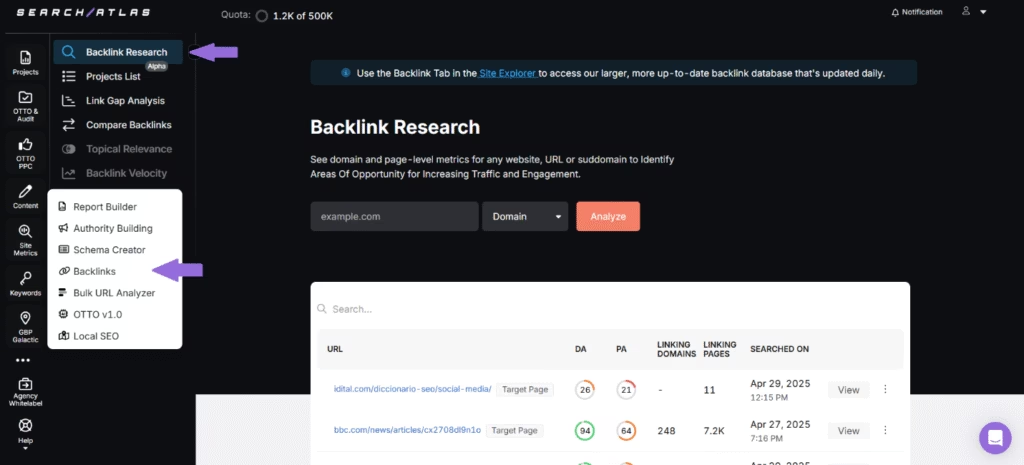
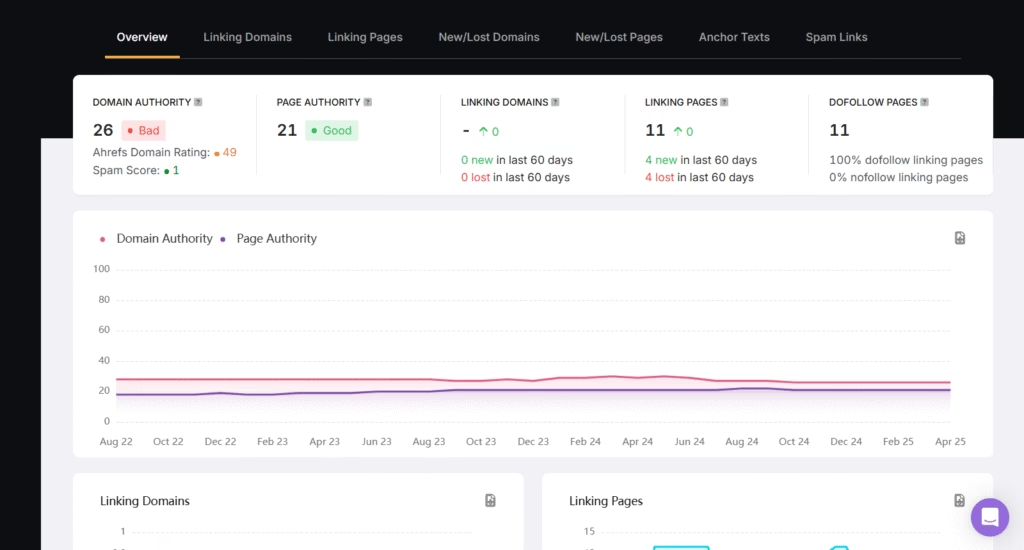
The Search Atlas Backlink Profile Comparison Tool allows you to compare your website’s backlink profile with up to six competitors side by side. The Search Atlas Backlink Profile Comparison Tool analyzes essential SEO metrics such as Domain Authority, Page Authority, total linking pages, linking domains, and more to help you identify gaps, evaluate your competitive standing, and uncover opportunities to strengthen your link-building strategy.
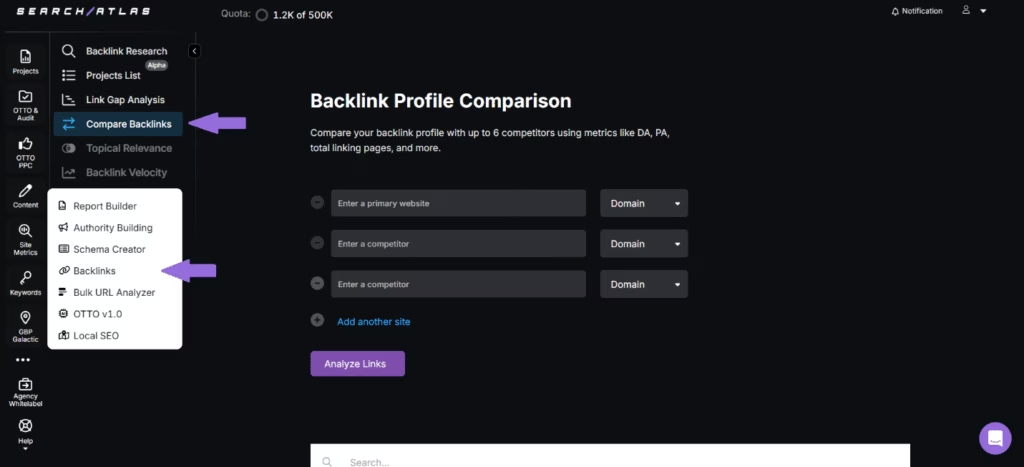
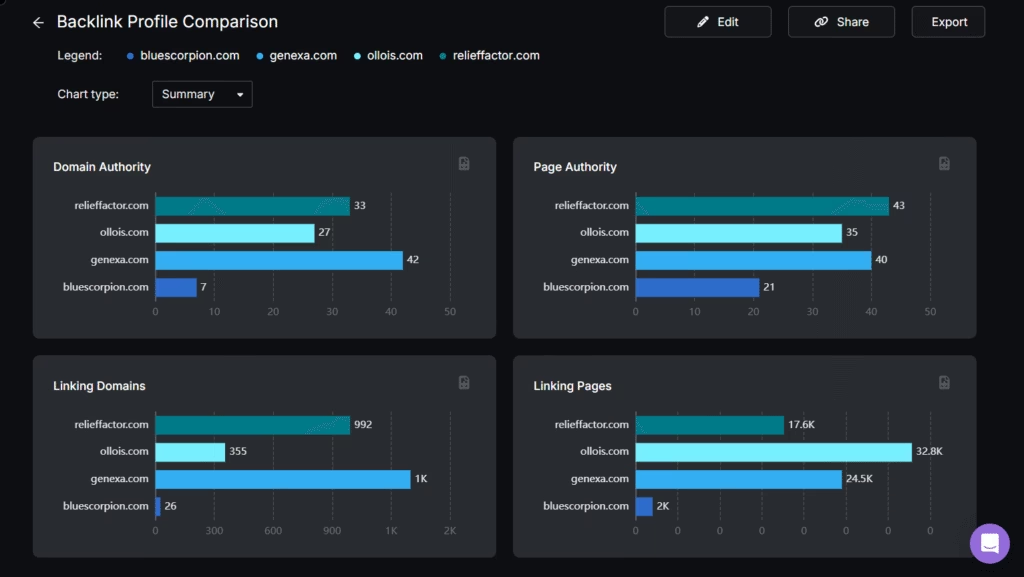
10. Manage Local SEO
Managing local SEO means optimizing a website and online presence to appear in location-based search results for users in a specific geographic area. Managing local SEO includes targeting local keywords, maintaining accurate business listings, and engaging with local audiences.
Managing local SEO improves overall SEO by increasing visibility in “near me” and geo-targeted searches. Optimizing and maintaining local search visibility helps businesses rank higher on Google Maps and local packs, drives more foot traffic, and attracts customers actively looking for nearby services or products. Additionally, strong local SEO builds trust and authority within the community and boosts relevance for local search queries.
The tips to manage local SEO are listed below.
- Create and verify a Google Business Profile with an accurate name, address, phone number, and business hours.
- Use local keywords naturally in titles, meta descriptions, headers, and content.
- Encourage customers to leave positive reviews and respond to them promptly.
- Ensure NAP (Name, Address, Phone number) consistency across all directories and platforms.
- Build local citations on trusted business directories like Yelp, Bing Places, and Apple Maps.
- Add location pages with unique content for each area served, including local landmarks and testimonials.
- Embed a Google Map on the contact page to improve local relevance.
- Post updates, offers, and events regularly on the Google Business Profile.
- Optimize for voice search using conversational keywords related to local intent.
- Monitor competitor local SEO strategies to identify gaps and opportunities in your market.
The Search Atlas SEO Software Platform offers a comprehensive set of tools designed to elevate your local SEO strategy. The Search Atlas Local SEO Heatmap Tool helps you uncover the most valuable location-based keywords for your business by visually highlighting which search terms are driving visibility in your target geographic areas. The Search Atlas GBP Optimization Tool provides clear, actionable recommendations to optimize your GBP and increase local rankings. Together, these tools streamline local SEO management and improve your visibility where it matters most.
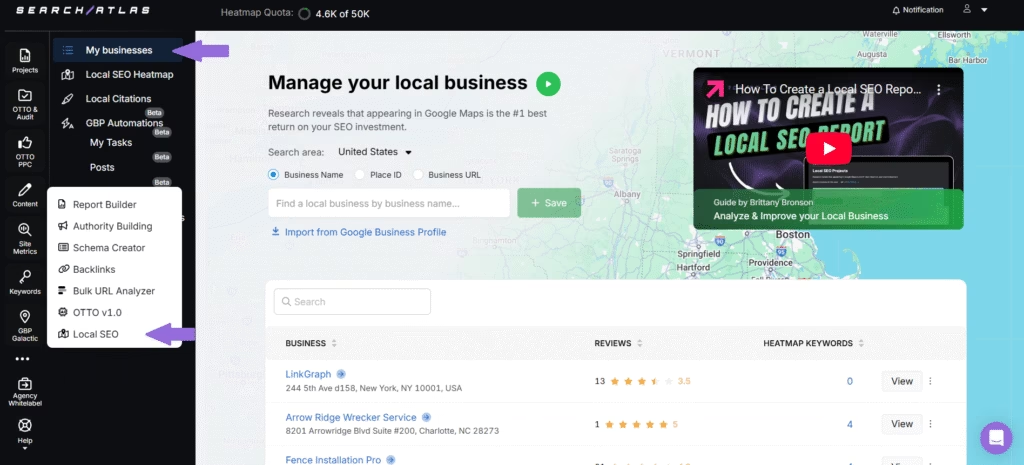
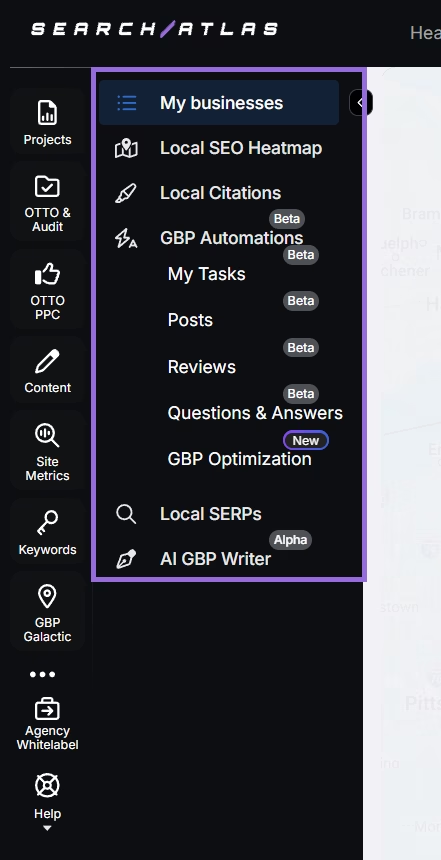
What Are the Types of SEO Maintenance?
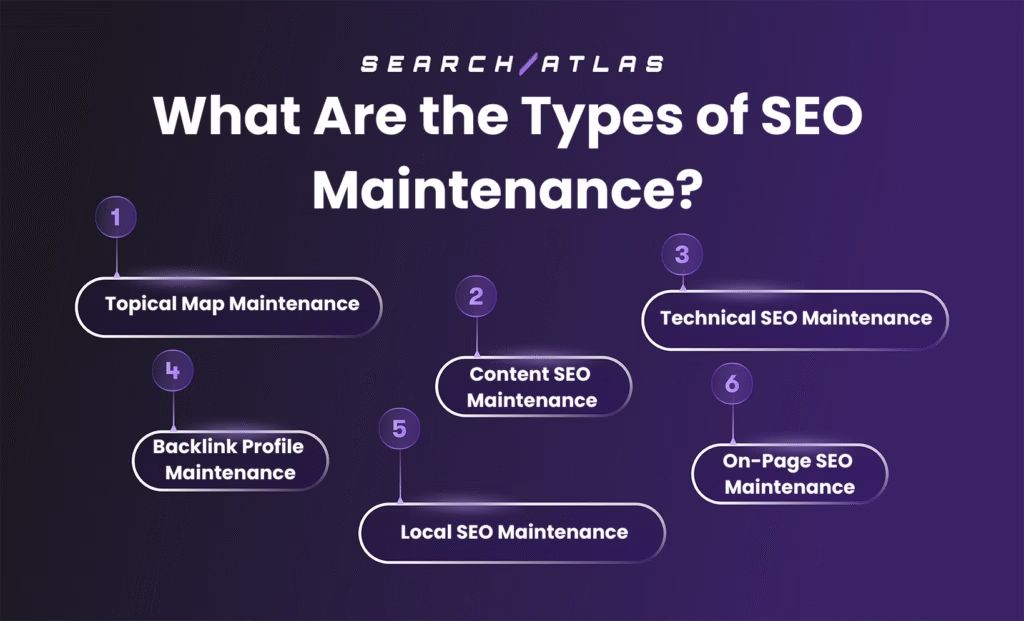
The types of SEO maintenance cover the core areas needed to keep a website optimized, functional, and competitive in search engine results. The main types of SEO maintenance are discussed below.
- Topical Map Maintenance. Topical map maintenance involves updating and refining the site’s content structure to maintain strong topical authority. Topical map maintenance guarantees the website covers all relevant subtopics within a niche, fills content gaps, and links related content together to support keyword relevance and improve internal linking.
- Content SEO Maintenance. Content SEO maintenance includes regularly refreshing, updating, and optimizing existing content. Content SEO maintenance guarantees accuracy, aligns with current search intent, and keeps pages competitive. The content SEO maintenance activities include keyword updates, meta tag adjustments, adding new information, and removing outdated sections.
- Technical SEO Maintenance. Technical SEO maintenance makes sure that the website functions smoothly and remains crawlable and indexable by search engines. Technical SEO maintenance includes fixing crawl errors, improving page speed, optimizing mobile usability, updating sitemaps, managing redirects, and resolving security issues.
- Backlink Profile Maintenance. Backlink profile maintenance focuses on analyzing, cleaning, and strengthening the website’s backlink profile. Backlink profile maintenance involves disavowing harmful links, gaining high-quality backlinks, monitoring anchor text usage, and building links from authoritative and relevant sources to boost domain authority.
- Local SEO Maintenance. Local SEO maintenance includes managing Google Business Profile listings, verifying citation consistency, collecting local reviews, and optimizing local landing pages. Local SEO maintenance helps businesses maintain visibility in location-based searches and attract local traffic.
- On-Page SEO Maintenance. On-page SEO maintenance involves reviewing and optimizing on-page elements like title tags, meta descriptions, headers, image alt texts, and keyword placement. On-page SEO maintenance ensures every page remains search-friendly and aligned with the latest ranking factors.
These SEO types in maintenance make sure a website stays optimized for both users and search engines. Ongoing efforts across all these areas build long-term SEO success, help recover from algorithm updates, and keep the website ahead of competitors.
What Tools to Use for SEO Maintenance?
The tools to use for SEO maintenance include Google’s free, foundational tools and the Search Atlas SEO Software Platform’s SEO tools.
Google offers a suite of free tools that cover essential areas for SEO maintenance. Google Search Console helps track indexing status, keyword performance, mobile usability, and crawl errors. Google Analytics monitors traffic sources, user behavior, and goal conversions. Additionally, Google PageSpeed Insights evaluates site speed and core web vitals, offering recommendations to improve load times and performance.
Search Atlas SEO Software Platform, on the other hand, offers a comprehensive set of SEO tools for deeper insights and strategic optimization. The Search Atlas Keyword Rank Tracker Tool automatically monitors target keyword rankings and provides insights on position, search volume, SERP features, and competitor visibility to help adjust SEO strategy. The Search Atlas Site Auditor Tool scans websites for crawlability, indexability, and site structure issues, combining data from Google Search Console and Analytics for targeted technical SEO improvements.
The Search Atlas Scholar Tool grades content quality based on Google’s Page Quality Algorithm and offers actionable insights to enhance content relevance and search performance. The Search Atlas On-Page Audit Tool evaluates page content by comparing it against top competitors, analyzing factors like word count, readability, and SEO elements to identify areas needing improvement. The Search Atlas Content Genius Tool uses AI and NLP to generate SEO-optimized content briefs, including suggested headings, questions, topical terms, and links based on top-performing articles.
Additionally, the Search Atlas Schema Markup Generator Tool helps create accurate JSON-LD structured data markup aligned with Schema.org standards and provides easy testing through Google’s Rich Results Testing Tool. The Search Atlas Keyword Gap Tool compares keyword rankings with up to six competitors to reveal missed opportunities and gaps in keyword coverage for expanding content strategy. The Search Atlas Site Explorer Tool’s Topical Dominance Tab compares your site’s topical authority to competitors’, identifying strengths and content gaps to refine SEO focus.
Moreover, the Search Atlas Backlink Research Tool analyzes backlink profiles in detail, tracking linking domains, anchor text, new or lost links, and potential spam to support link-building and site authority. The Search Atlas Backlink Profile Comparison Tool compares backlink profiles with multiple competitors side by side to uncover gaps and opportunities for improving link strategies. The Search Atlas Local SEO Heatmap Tool visually identifies high-value local keywords driving visibility within target geographic areas for stronger local SEO. The Search Atlas GBP Optimization Tool offers actionable recommendations to optimize Google Business Profile listings and increase local search rankings.
Using a mix of Google’s free tools and the Search Atlas SEO Software Platform’s paid SEO tools gives a well-rounded approach to ongoing website maintenance. While Google’s free tools cover the basics, adding powerful yet cheap SEO tools from the Search Atlas SEO Software Platform gives you access to advanced features like keyword tracking, backlink analysis, and competitor insights, making them ideal for businesses looking to grow smarter, not just spend more.
What Are the SEO Monthly Maintenance Plans?
SEO monthly maintenance plans are ongoing service packages that make sure your website maintains and improves its search engine rankings over time. These comprehensive plans focus on continuous monitoring, updating, and improving various SEO elements such as content, technical health, backlinks, and user experience. The goal of SEO monthly maintenance plans is to sustain and grow organic traffic, boost search rankings, and adapt to changing algorithms and market trends.
The most common SEO monthly maintenance plans are listed below.
- Basic SEO Maintenance Plans. Basic SEO maintenance plans typically range from $500 to $1,500 per month and include fundamental activities like monthly keyword ranking reports, basic on-page optimization updates, meta tag adjustments, and content recommendations.
- Standard SEO Maintenance Plans. Standard SEO maintenance plans generally cost between $1,500 to $4,000 monthly and offer more comprehensive services. These plans include everything from basic packages plus regular content creation, local SEO optimization for businesses with physical locations, competitor analysis, and link-building activities.
- Premium SEO Maintenance Plans. Premium SEO maintenance plans range from $4,000 to $10,000 or more per month and provide enterprise-level services. These comprehensive packages include extensive content marketing strategies, advanced technical SEO implementations, custom reporting dashboards, and dedicated account management.
- Enterprise SEO Maintenance Plans. Enterprise SEO maintenance plans are customized solutions for large organizations with complex websites and competitive industries. These monthly SEO maintenance packages typically start at $10,000 monthly and can exceed $25,000, depending on the scope. Enterprise SEO maintenance plans include strategic SEO consulting, large-scale content production, advanced technical implementations, multi-location SEO management, and integration with enterprise marketing systems.
Most SEO maintenance plans include core activities such as monthly performance reporting, ongoing keyword monitoring, technical site health checking, content optimization recommendations, and regular communication through calls or meetings. The key difference between plan levels is typically the depth of service, frequency of activities, amount of content created, and the level of strategic guidance provided.
What Businesses Need SEO Maintenance the Most?
There are certain businesses that require SEO maintenance more than others due to their competitive landscapes, dynamic content needs, and the importance of maintaining strong search rankings to drive traffic and sales. The businesses that need SEO maintenance the most are given below.
- E-commerce businesses. E-commerce businesses need SEO maintenance because their product inventories change regularly, and they operate in highly competitive markets. Continuous SEO helps keep product pages optimized for relevant keywords, ensures fast site performance, and improves user experience, which increases traffic and boosts conversion rates. Additionally, e-commerce SEO helps these businesses stay visible amid fluctuating search trends and seasonal demands.
- Professional service-based businesses. Professional service-based businesses such as law firms, consultants, and medical practices require SEO maintenance to build and maintain trust and authority online. Regular content updates and local SEO efforts make sure these businesses appear in relevant local searches, making it easier for potential clients to find them. Moreover, SEO for service-based businesses enhances reputation and credibility by showcasing expertise, which leads to higher client engagement and more inquiries.
- SaaS and tech companies. SaaS and tech companies operate in rapidly changing industries where innovation happens quickly, so they need continuous SEO maintenance to keep their product and support content current and competitive. SaaS SEO helps these businesses increase visibility for targeted keywords, attract qualified leads, and support content marketing strategies that educate and convert users throughout the sales funnel.
- Startups and SMEs. Startups and SMEs need SEO maintenance to build a strong online presence and compete with established companies. SEO provides these businesses a cost-effective way to increase brand awareness, drive organic traffic, and generate leads without depending solely on paid advertising. SEO for startups and SMEs helps them adapt to market changes and grow sustainably over time.
- Small Businesses. Small businesses need SEO maintenance to build consistent online visibility and attract local customers without relying heavily on paid ads. Regular updates to their website, local listings, and content help them compete with larger companies and stay relevant in search engine results. Moreover, small business SEO helps these businesses increase foot traffic, generate leads, and convert local interest into loyal customers.
- Travel Businesses. Travel businesses benefit from SEO maintenance because travel trends and customer preferences often change seasonally. Regular updates and optimization of destination pages, travel guides, and booking systems increase search rankings and attract travelers researching their next trip. Additionally, effective travel SEO helps businesses stay competitive and convert visitors into customers.
- Restaurants and Cafes. Restaurants and cafes require SEO maintenance mainly to manage their local search visibility and online reputation. Optimizing menus, responding to reviews, and maintaining accurate Google Business Profiles improve local rankings, attract nearby customers, and encourage repeat visits. Robust restaurant SEO supports these businesses in standing out in crowded local markets and driving foot traffic.
- Real estate agencies. Real estate agencies need SEO maintenance to keep property listings fresh and visible in search results. Real estate SEO helps target buyers and renters actively searching for homes by improving page rankings, speeding up site performance, and providing useful content about neighborhoods and market trends.
- Health and wellness providers. Health and wellness providers require SEO maintenance to educate potential patients and build online trust. Healthcare SEO helps these businesses increase their chances of ranking for relevant health topics, which drives patient inquiries and appointments.
- Educational institutions. Educational institutions need SEO maintenance to attract prospective students and highlight programs and events. SEO helps schools increase visibility in competitive educational search results, guiding students toward enrollment and participation.
These businesses require SEO maintenance because it helps them maintain strong search rankings, stay relevant amid changing market conditions, attract their target audiences, and support sustainable growth. SEO benefits them by improving visibility, enhancing user experience, and generating valuable leads and conversions over time.
Does SEO Maintenance Improve SEO Performance?
Yes, SEO maintenance does improve SEO performance by guaranteeing websites adapt to constantly changing search engine algorithms, fixing technical issues that impact rankings, and optimizing content for new keyword opportunities. Regular maintenance activities prevent gradual ranking decline while competitors implement fresh strategies and search engines update their ranking criteria. Additionally, consistent SEO maintenance creates sustained SEO performance improvement rather than maintaining current positions, making ongoing investment essential for businesses seeking long-term organic visibility and traffic growth.
What is the Difference Between SEO Maintenance and SEO Site Audit?
The difference between SEO maintenance and an SEO site audit is that SEO maintenance is an ongoing process to sustain and boost SEO performance, while an SEO site audit is a one-time, comprehensive evaluation of a website’s current SEO health.
SEO maintenance refers to the continuous tasks and updates carried out to keep a website optimized for search engines and users. SEO maintenance includes updating content, fixing broken links, monitoring keyword rankings, improving technical performance, and adjusting to algorithm changes. The main goal of SEO maintenance is to sustain and enhance long-term search visibility, user experience, and overall website performance.
SEO site audit, by contrast, is a deep, one-time analysis of a website to identify existing SEO issues across technical, on-page, and off-page factors. An SEO site audit helps uncover problems that affect indexability, crawlability, site speed, and keyword optimization. The main goal of an SEO site audit is to detect SEO weaknesses and create a roadmap for optimization.
What to Know About SEO Maintenance Besides SEO Strategy?
SEO maintenance is the continuous process of monitoring, updating, and improving a website to make certain that it stays aligned with search engine algorithms, performs well in search rankings, and delivers a smooth user experience. SEO maintenance involves regular checks on technical elements, content quality, keyword performance, and overall site health to maintain and boost long-term SEO results.
SEO strategy, on the other hand, is the long-term, high-level plan that outlines how a website will attract organic traffic through search engines. SEO strategy includes setting SEO goals, identifying target keywords, analyzing competitors, creating a content plan, and aligning SEO efforts with business objectives.
SEO maintenance and SEO strategy work together to achieve sustainable growth in search visibility. While SEO strategy sets the direction, SEO maintenance ensures the website stays on track and continues performing well over time.









